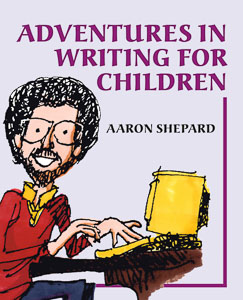The Internet has brought remarkable opportunities not only in education and literature but also in the interface between them. Watching the Internet’s early growth, I began to dream of sending my unfinished stories to some of the children I wrote for, to garner comments that would help me in revision. By 1995, the technology for such a project was at hand.
In early January of that year, I composed an invitation entitled “Works in Progress: An Online Experiment.” This invitation was sent to various discussion lists and newsgroups for teachers and librarians, as well as to teachers identified from the member directory of America Online. (I learned only later that AOL prohibited that!)
My posts and emails brought the invitation directly to the attention of thousands, and from there it was shared—online and off—with many more. Here in part is what it said:
If you are working with young people in grades 3–6 in the first quarter of 1995, I invite you to take part in a collaborative online experiment in literature and education.
Works in Progress is a program in which educators and librarians will receive stories as email from an established children’s author. These “works in progress” have not yet reached final form. Participants will be asked to share the stories with young people and to relay comments back to the author, as well as to comment themselves.
While the author gains valuable feedback, kids will gain interest in and appreciation of the creative process—and both kids and adults will enjoy the opportunity to influence stories headed for publication.
The stories selected are “The Man Who Knew Everything: A Tale of Iran,” and “Nonviolence: A Buddhist Fable.” Participants may respond to one or both of the stories. Supplementary materials include a letter to the kids, suggested questions for discussion, and an author profile.
There is no charge for the program. To receive the materials, just send me an email request at one of the addresses below. Stories will be sent to the return address at the head of your email message.
The response was overwhelming. Within a few weeks, I had received requests from 500 email addresses around the world. Many of these addresses represented multiple classrooms, or even multiple schools. As it turned out, most of the signups failed to return comments—primarily due to time constraints, judging from explanations I received. Still, by around the deadline of March 1, comments had been emailed from about 200 addresses. By my best estimate, about 5,000 students took part!
Luckily, I had the foresight to request that the responses be collective, rather than from individual students. Even so, the comments amassed into a two‑inch pile of printouts. My job then was to sift through the pile, determine the predominant reactions, and use them to guide my revision of both stories.
This job was complete by mid‑April. At that time, I sent my revisions to all participants. With the revisions went a report on the most important comments I had received, what I had used, what I had decided against using, and my reasons. And I cautioned everyone that the stories were still not in final form—because I keep revising and improving my stories right up to publication, and sometimes after! I also described my plans for getting each story published, and promised to send major news of my progress.
Was the project successful? Wildly so. For my own part, I gained valuable insights into how kids were able to deal with these two stories in particular and multicultural literature in general. Both stories became stronger, and I gained a better idea of each one’s potential.
Perhaps as a result, I was able to report sales of both stories by November. “Nonviolence,” now retitled “How Violence Is Ended,” eventually appeared in Cricket, Australia’s School Magazine, and Parabola. “The Man Who Knew Everything” too appeared in School Magazine and Parabola; and retitled as “Forty Fortunes,” it went on to become a picture book from Clarion.
Aside from that, the project introduced me as an author to thousands of enthusiastic teachers, librarians, and students I might otherwise never have reached. Numerous schools inquired about visits, and one school flew me to Indiana. Another high point came when two teachers organized an online chat with me for thirty classes all across the continent, meeting in the Electronic Schoolhouse of America Online—years before virtual author visits became common.
As for benefits to the participants, here are some of the teachers’ own words:
“I can’t tell you how inspired my students have found your efforts to make your stories better and better by rewriting and revising. They are so much more enthusiastic about revising their own stories.”
“It has been one of the best things we have been able to do with them this year. One of the most telling things was when they realized you actually had a reason for changes you made and didn’t make.”
“The whole idea was wonderful. It lets them see the purpose to the writing process when they can see it put to use in the ‘real world’ of literature!”
“This was a terrific experience for them. Not only did it help them develop critical thinking, it made them feel VERY important helping a real author.”
“For many of the students, this was among the first activities that excited them about literature. They could make a difference; language was real and with a purpose.”
As valuable as the project was, I never did find time to repeat it. But this and similar opportunities await other authors willing to use the Internet to bridge the gap between themselves and their readers—not only in promoting published work but in sharing the heady process of creation.
